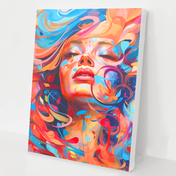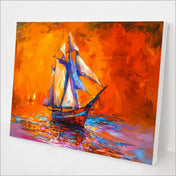Hello, friend and fellow colour enthusiast!
Welcome to the vibrant, joyous world of Paint Plot. Today, we're embarking on a paint-splattered journey to understand the colour theory behind Paint by Numbers. Don't worry; we won't let things get too theoretical. After all, we're here to have fun, aren’t we?
Let’s take a spin on the colour wheel!
Let’s start with complementary colours. These are the drama queens of colour theory, demanding attention by being exactly opposite to each other on the colour wheel. Think red and green or blue and orange. In a Paint by Numbers project, complementary colours inject a dose of high contrast, making elements of your painting pop!
We’ve also got analogous colours. These are colours that sit side by side on our colour merry-go-round, like red, orange, and yellow, or green, blue, and purple. In a Paint by Numbers kit, analogous colours often work together to create harmony and cohesion. It's like an ensemble cast of a sitcom, each character different, yet part of a larger, lovable squad.
Next on the list are colour values. No, we're not talking about how much a colour costs, but rather the lightness or darkness of a colour. By using different colour values, you can create depth and dimension in your painting. It's like your flat, 2D canvas suddenly puts on a pair of 3D glasses. Voila! You have hills rolling into the distance, or a nose that now looks like it could actually sniff!
Now, imagine colours as personalities. Warm colours, like reds, yellows, and oranges, are the extroverted, energetic ones. They're like a sunny day at the beach, full of life and excitement. Here are some warm Paint Plot paintings (https://paintplot.com.au/search?type=product&q=orange).
Cool colours, on the other hand, such as blues, greens, and purples, are calm, soothing, and introspective. Think of a peaceful twilight, as day gives way to night. Check out some cooler Paint Plot paintings here:
https://paintplot.com.au/search?type=product&q=blue
Understanding this can help you set the mood of your painting. Do you want it to be a party or a quiet evening at home?
This leads us to colour psychology. Ever wondered why certain colours evoke specific feelings? Well, different colours are said to trigger different emotions. For instance, blue tends to have a calming effect, while red can evoke intensity and passion. So, the next time you're selecting a Paint by Numbers kit, think about the mood or ambiance you'd like to create. Trust us; it's like choosing the perfect soundtrack for your movie scene!
By understanding colour theory, you can predict how your finished Paint by Numbers project will look, choose the order of painting (light to dark or vice versa), and select kits based on colour preferences or challenges. It’s like having the inside scoop, the VIP backstage pass to the colour show.
So, why is colour theory a valuable tool for Paint by Numbers enthusiasts? Because it deepens your understanding of why certain colours work together, how they affect the mood of your painting, and how they can bring your artwork to life. It’s like suddenly understanding the lyrics of a song you’ve been humming for ages. And let’s be honest, it does add a bit of swag to your paint-dipped swagger, doesn't it?
Remember, our journey into the world of colours is about enjoyment as much as it is about knowledge. Embrace the theory, but also let your instincts guide you. After all, there's no such thing as a wrong colour, just an opportunity to create something uniquely yours.Happy painting!



